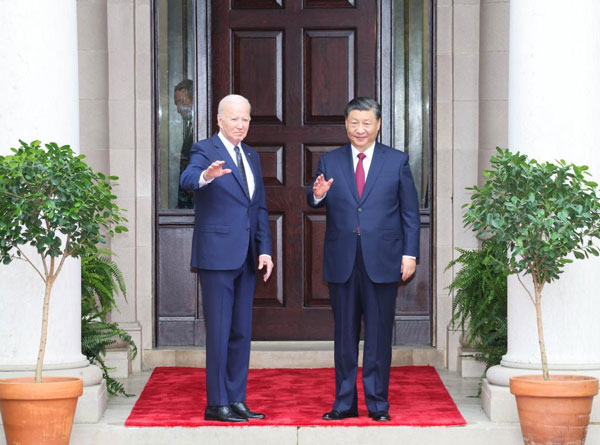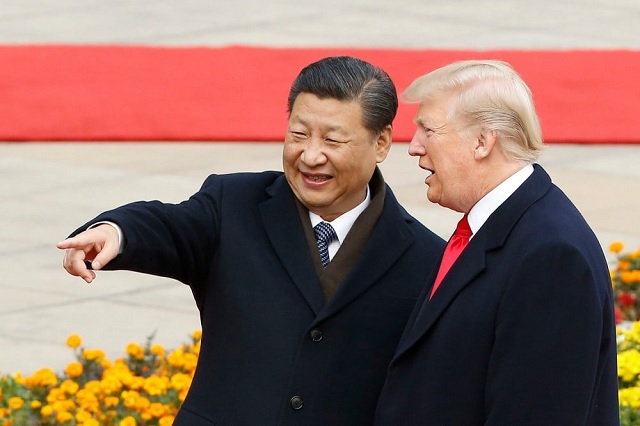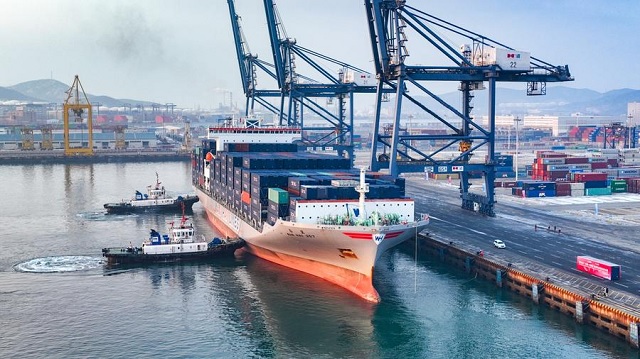
BEIJING, CHINA | Xinhua | Though clashing in many ways, the current U.S. administration and its Republican predecessor have one thing in common: the trade war against China.
As recently as February, U.S. utility company Duke Energy, under pressure from Congress, reportedly planned to remove Chinese battery giant CATL from a Marine Corps base over “national security concerns,” a well-tried pretext of the Joe Biden administration to contain China — from discriminatory policies like the Inflation Reduction Act and the CHIPS and Science Act, to tariffs, export controls and investment reviews, to name but a few.
It’s a continuation of the policies spearheaded by Donald Trump, Biden’s predecessor. Since March 2018, Trump has imposed tariffs on Chinese imports valued at 370 billion U.S. dollars, and restricted Chinese investment. Amid the escalating trade frictions, he also included Huawei and its 114 affiliates in a blacklist of entities in May 2019.
Since the two presidents still seem to believe America’s economy is too reliant on China, has their country gained anything from the years-long trade war? And what does this mean for China?
CHINESE IMPORTS STILL HUGE, BUT ON LONGER ROUTE
One of the key considerations behind the trade war, as Trump has claimed, was to reduce the country’s trade deficit and dependence on Chinese goods.
Even if one agrees with Trump’s logic, his policy does not work. According to the U.S. Department of Commerce, the U.S. goods trade deficit stood at 1.06 trillion dollars in 2023, far higher than that before the trade war, with its trade deficit with Mexico rising by nearly 17 percent year on year. Economists have said that the U.S. trade deficit stems from inner problems such as insufficient savings, which are not likely to be cured by outward actions.
In essence, Trump’s deficit rhetoric could be a fallacy. “Many economists and trade experts do not believe that trade deficits hurt the economy, and warn against trying to ‘win’ the trade relationship with particular countries,” and there is substantial debate over how much of the trade deficit is caused by foreign governments, wrote James McBride and Andrew Chatzky from the think tank the Council on Foreign Relations.

What’s more, despite U.S. “de-coupling” attempts, trade links between China and the United States remain tight, though masked by politicians’ talks, according to an analysis by The Economist. Direct trade has fallen and the United States is seeking “friendshoring” countries to shift its production away from China, but these countries often “act as something akin to packaging hubs for goods made with Chinese inputs that are destined for America’s shores.”
That has complicated global supply chains and raised costs. Researchers at the Bank for International Settlements said in a paper released in October 2023 that cross-border supplier networks — especially those involving China and the United States — have lengthened since 2021 but not become denser.
“In other words, the average number of suppliers per customer hasn’t increased. More circuitous supply chains with the same number of suppliers smacks of increased complexity and reduced transparency — but not necessarily more resilience,” said a Wall Street Journal article, citing the paper.
To his fellow Americans, Trump also pledged to bring back manufacturing and jobs, which has failed, too. The tariffs that Trump placed on foreign metals, washing machines and an array of goods from China starting in 2018 have neither raised nor lowered the overall number of jobs in the affected industries, showed a recent working paper by authors from the Massachusetts Institute of Technology, University of Zurich, Harvard University and World Bank.
Even worse, the tariffs incited other countries to impose retaliatory tariffs on American products, making them more expensive to sell overseas, which in turn had a negative effect on American jobs, said the paper published by the National Bureau of Economic Research.
Regarding agriculture, the trade war has led to “a decline in U.S. farm exports, farm jobs, and jobs in farm regions,” devastating U.S. farmers, particularly in the Midwest and Deep South, said an article by Christina Pazzanese published on March 13 in The Havard Gazette.
Tariffs on Chinese imports have also caused high prices of related U.S. goods, and ensuing hiking inflation, a major challenge facing the U.S. economy in recent years. Over the past four years, grocery prices have jumped by 25 percent, according to the U.S. Department of Agriculture.
UNDERMINED GLOBAL TRADE RULES
The trade war also has its global spillover, as the U.S. unilateral and protectionist impositions, which were solely based on U.S. domestic law and bypassed the World Trade Organization’s (WTO) dispute settlement mechanism, have damaged the international multilateral trading system.
Since 2017 when Trump, an “America First” advocate, was sworn in, the United States has been eroding the WTO’s principles. In 2019, the United States blocked the selection of judges of the WTO’s Appellate Body, suspending the multilateral trade arbitration body, which exposed the system to a grave threat.
The “Section 301 investigation,” which originated from the Cold War era and Trump initiated against China to start the trade war, is notorious in international trade history. In September 2020, a WTO panel ruled that the Section 301 tariffs violated WTO rules.
However, the Biden administration has still acted against globalization, frequently restricting the export of high-tech products and equipment, citing “national security.” In the latest development, the United States has launched an investigation into Chinese-made vehicles that use “connected” car technology.
Now, as Biden and Trump have both clinched presidential nominations, U.S. politicians are hyping trade bullying policies as campaign bids, which has cast more uncertainty on global trade and the economy.
Trump said that if elected, he would raise tariffs on Chinese imports to 60 percent, or even higher. That would “blow the WTO to pieces” and demolish the world trade order, Martin Wolf, chief economics commentator at the London-based Financial Times, told Xinhua.
However, the United States is “not benefiting from” the trade war “at all,” Jean Christophe Iseux von Pfetten, chairman of the Institute for East-West Strategic Studies in Britain, told Xinhua, adding that so-called de-risking and de-coupling are “totally wrong.”
Revoking America’s Permanent Normal Trade Relations status for China over the five-year period would lead to a peak loss of 744,000 American jobs, and a cumulative loss of 1.6 trillion dollars in U.S. gross domestic product (GDP), showed a report released in November 2023 by the U.S.-China Business Council and advisory firm Oxford Economics.
WHAT ABOUT CHINA?
So, how has the trade war influenced the Chinese economy?
In terms of trade data, China remains the world’s largest exporter and second-largest importer. Over the past six years, China’s imports and exports with countries participating in Belt and Road cooperation have continued to grow, reaching 19.47 trillion yuan (2.69 trillion U.S. dollars) in 2023, from 7.37 trillion yuan in 2017, shows data from the National Bureau of Statistics of China.
Last year, China’s exports of the tech-intensive green trio — lithium-ion batteries, photovoltaic products, and new energy vehicles — amounted to 1.06 trillion yuan, exceeding the 1-trillion-yuan mark for the first time with an increase of 29.9 percent year on year. In the first two months of this year, China’s total imports and exports of goods expanded 8.7 percent year on year in yuan terms.
Regarding trade networks, a major trading partner of more than 140 countries and regions, China has inked 22 free trade agreements with 29 countries or regions, applied the highest standards in implementing the Regional Comprehensive Economic Partnership agreement, and taken proactive steps to align its economic and trade rules with the high standards of the Comprehensive and Progressive Agreement for Trans-Pacific Partnership and the Digital Economic Partnership Agreement.

Globally, China has upheld the multilateral trading system, and promoted freer and more convenient trade and investment.
Chile, the first South American country to sign a free trade agreement with China, has seen China become its largest trading partner, with fruits being major goods between the two sides.
“We are optimistic about the resilience and consumption vitality of the Chinese market and hope to achieve greater development through the Chinese market,” said Ivan Marambio, president of the Chilean Fruit Exporters Association.
“The Chinese market is so important for us!” he further said.
In fact, the Chinese market also still matters much to the United States, and vice versa. According to an editorial by The Washington Post published on Tuesday, U.S. export of goods to China, though with smaller growth, still stands high, and China remains a key market for U.S. services, while China needs access to America’s vast market for its exports, too.
Moreover, among U.S. states, California has the most jobs supported by exports to China, which also support a large number of agricultural and livestock jobs in the U.S. heartland, including Kansas, Nebraska, North Dakota and South Dakota, as well as Texas, the article noted, adding that the analysis “doesn’t even mention the benefits that low-price Chinese goods provide to U.S. consumers.”
“The U.S. and Chinese economies, the world’s largest and second-largest, are intertwined and interdependent — and destined to remain so for some time,” it said, describing the talk of trying to decouple or de-link the two as “a fallacy.”
 The Independent Uganda: You get the Truth we Pay the Price
The Independent Uganda: You get the Truth we Pay the Price


